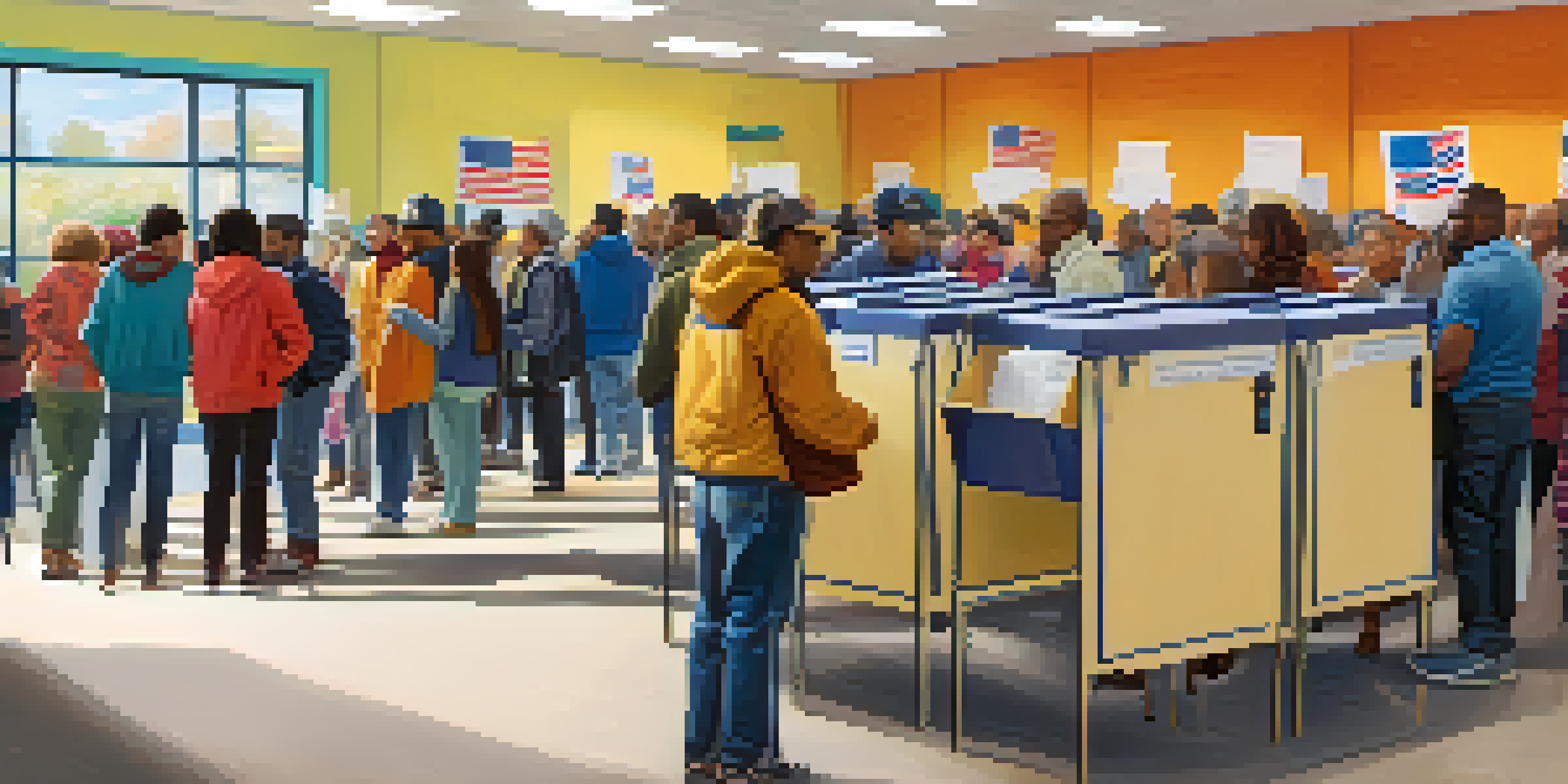Comparing Traditional and Decentralized Voting Methods

Understanding Traditional Voting Methods
Traditional voting methods refer to the established processes many countries have used for decades, such as in-person voting at polling stations or absentee ballots. These methods often involve physical ballots that are cast and then counted manually or via electronic machines. One of the primary advantages is the sense of security that comes from a familiar system, as voters can physically verify their participation.
Voting is a civic sacrament.
However, traditional voting methods have their drawbacks, including long lines, accessibility issues, and the potential for human error during the counting process. In addition, these systems can be vulnerable to tampering, which can undermine public confidence in electoral integrity. As technology evolves, the desire for more efficient and secure methods has led to the exploration of alternatives.
Despite its flaws, traditional voting remains a cornerstone of democratic processes worldwide. Many voters feel a sense of connection to their community when voting in person, and the act of casting a ballot has deep cultural significance. Understanding these methods is crucial before we delve into newer alternatives.
Introduction to Decentralized Voting
Decentralized voting refers to systems that leverage technology, particularly blockchain, to allow for secure and transparent voting processes. Unlike traditional methods, decentralized voting enables voters to cast their ballots online from anywhere, making participation easier and potentially increasing voter turnout. The use of encryption and distributed ledgers helps ensure that votes are secure and tamper-proof.

One of the most significant benefits of decentralized voting is its ability to enhance transparency. With every vote recorded on a public ledger, it’s much easier to verify results and hold elections accountable. This openness can help rebuild trust in electoral processes, particularly in regions where fraud has been a concern.
Traditional Voting's Benefits & Flaws
Traditional voting methods provide a sense of security and community connection but face challenges like accessibility and potential tampering.
However, decentralized voting is not without its challenges. Concerns about digital literacy, cybersecurity, and equitable access to technology must be addressed to ensure that all voters can participate effectively. As we explore these voting methods, it’s essential to weigh their potential against the obstacles they present.
Comparing Security Features
Security is paramount in any voting system, and comparing the two methods highlights significant differences. Traditional voting often relies on physical security measures, such as locked ballot boxes and monitored polling places. While these methods have served well historically, they are not immune to risks like voter intimidation or ballot tampering.
The ballot is stronger than the bullet.
On the other hand, decentralized voting employs cryptographic techniques and distributed networks to enhance security. By using blockchain technology, each vote is securely encrypted and linked to a chain of votes, making it nearly impossible to alter any single vote without detection. This feature can significantly reduce the risk of fraud, as the system itself acts as a safeguard.
Despite these advantages, decentralized voting also faces its own security concerns, particularly regarding hacking and technology failures. Ensuring robust cybersecurity measures are in place is crucial to prevent potential breaches that could undermine the system. Therefore, while each method has unique security features, ongoing vigilance is essential in both scenarios.
Voter Accessibility and Participation
Accessibility plays a crucial role in voter participation, and this is where decentralized voting shines. With the ability to vote online, individuals who may find it difficult to reach polling places—such as the elderly, disabled, or those living in remote areas—can more easily participate. This accessibility can lead to higher voter turnout, which is vital for a healthy democracy.
In contrast, traditional voting often presents challenges, including long wait times and limited polling hours. These barriers can discourage people from casting their votes, especially those who have demanding work schedules or family obligations. Additionally, not all communities have equal access to polling locations, which can disproportionately affect marginalized groups.
Decentralized Voting Enhances Access
Decentralized voting systems increase accessibility and transparency, allowing voters to cast ballots online and potentially boosting turnout.
As we think about the future of voting, addressing accessibility issues is essential. Ensuring that all individuals can participate in the democratic process, regardless of their circumstances, should be a priority for any voting system, traditional or decentralized.
Cost Implications of Voting Methods
The cost of conducting elections can vary dramatically between traditional and decentralized voting methods. Traditional elections often require significant resources for polling locations, staffing, printing ballots, and counting votes. These expenses can add up quickly, putting a strain on government budgets, especially in larger jurisdictions.
Decentralized voting, while initially requiring investment in technology and infrastructure, can potentially reduce costs in the long run. By minimizing the need for physical polling locations and the associated logistics, funds can be redirected towards improving voter education and outreach. This shift could lead to more efficient use of taxpayer dollars.
However, it's essential to consider the upfront costs of implementing new technology. Transitioning to decentralized voting involves training personnel, ensuring cybersecurity, and addressing public concerns. Balancing these costs against potential savings is critical in evaluating the overall feasibility of each method.
Public Perception and Trust
Public trust in the electoral process is fundamental to any democracy. Traditional voting methods generally benefit from a long-standing history, which fosters a sense of reliability among voters. Many individuals are accustomed to these processes, and a strong familiarity can enhance their confidence in the system's integrity.
On the other hand, decentralized voting is still relatively new, and its adoption may face skepticism. Many people might worry about the security of online voting or the potential for technical failures. Building public trust requires transparent communication about the technology and rigorous testing before implementation.
Future Voting: A Hybrid Approach
A hybrid voting system combining traditional and decentralized methods could offer flexibility and cater to diverse voter needs.
Ultimately, fostering confidence in any voting method hinges on transparency, security, and education. As public perception evolves, both traditional and decentralized methods must continually adapt to meet the changing needs and expectations of voters.
The Future of Voting: A Hybrid Approach?
As we look ahead, the future of voting may not rest solely on traditional or decentralized methods, but rather a combination of both. A hybrid approach could leverage the reliability of in-person voting while integrating the accessibility and security of decentralized systems. This model could cater to a broader range of voter preferences and needs.
For instance, voters could have the option to choose between casting their ballots online or in person, allowing them to select the method that best suits their circumstances. This flexibility could enhance voter engagement and participation, leading to more representative outcomes in elections.

However, implementing a hybrid system requires careful planning and consideration of the strengths and weaknesses of each method. Ongoing dialogue among stakeholders, including voters, government officials, and tech experts, will be critical in shaping a voting system that is secure, accessible, and trusted by all.